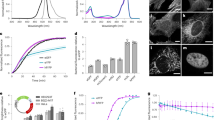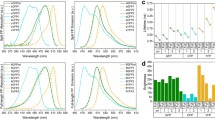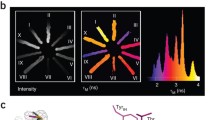Abstract
mEos3.2 is a photoconvertible fluorescence protein with comparatively low brightness, which limits its application in live Super resolution microscopy. To address this issue, we have used semi-rational protein engineering to develop mEosBrite, a new class of improved brightness variants. The improvement in the brightness was confirmed by expression in E.coli as well as mammalian cell lines. Furthermore, biophysical characterization suggests that all the three mEosBrite variant proteins display higher quantum yield, truly monomeric form, less cytotoxicity and lower protein aggregation as compared to the wild type mEos3.2 protein. Most importantly, because of their high photoconversion efficiency mEosBrite variants could be an excellent tool for single-molecule and intensity fluctuation based super-resolution microscopy.








Similar content being viewed by others
Abbreviations
- PFCP:
-
Photoconvertible Fluorescent Protein
References
Adam V, Berardozzi R, Byrdin M, Bourgeois D (2014) Phototransformable fluorescent proteins: Future challenges. Curr Opin Chem Biol 20:92–102
Baker SM, Buckheit RW 3rd, Falk MM (2010) Green-to-red photoconvertible fluorescent proteins: tracking cell and protein dynamics on standard wide-field mercury arc-based microscopes. BMC Cell Biol 11:15
Chudakov DM, Lukyanov S, Lukyanov KA (2007) Using photoactivatable fluorescent protein Dendra2 to track protein movement. Biotechniques 42:553 555, 557 passim
Cormack BP, Valdivia RH, Falkow S (1996) FACS-optimized mutants of the green fluorescent protein (GFP). Gene. 173:33–38
Cubitt AB, Heim R, Adams SR, Boyd AE, Gross LA, Tsien RY (1995) Understanding, improving and using green fluorescent proteins. Trends Biochem Sci 20:448–455
Gross LA, Baird GS, Hoffman RC, Baldridge KK, Tsien RY (2000) The structure of the chromophore within DsRed, a red fluorescent protein from coral. Proc Natl Acad Sci U S A 97:11990–11995
Heilemann M (2010) Fluorescence microscopy beyond the diffraction limit. J Biotechnol 149:243–251
Hell SW (2007) Far-field optical nanoscopy. Science. 316:1153–1158
Hoi H, Shaner NC, Davidson MW, Cairo CW, Wang J, Campbell RE (2010) A monomeric photoconvertible fluorescent protein for imaging of dynamic protein localization. J Mol Biol 401:776–791
Huang B, Babcock H, Zhuang X (2010) Breaking the diffraction barrier: super-resolution imaging of cells. Cell. 143:1047–1058
Matz MV, Fradkov AF, Labas YA, Savitsky AP, Zaraisky AG, Markelov ML, Lukyanov SA (1999) Fluorescent proteins from nonbioluminescent Anthozoa species. Nat Biotechnol 17:969–973
McKinney SA, Murphy CS, Hazelwood KL, Davidson MW, Looger LL (2009) A bright and photostable photoconvertible fluorescent protein. Nat Methods 6:131–133
Mizuno H, Mal TK, Tong KI, Ando R, Furuta T, Ikura M, Miyawaki A (2003) Photo-induced peptide cleavage in the green-to-red conversion of a fluorescent protein. Mol Cell 12:1051–1058
Nemet I, Ropelewski P, Imanishi Y (2015) Applications of phototransformable fluorescent proteins for tracking the dynamics of cellular components. Photochem Photobiol Sci 14:1787–1806
Nienhaus GU, Nienhaus K, Holzle A, Ivanchenko S, Renzi F, Oswald F, Wolff M, Schmitt F, Rocker C, Vallone B, Weidemann W, Heilker R, Nar H, Wiedenmann J (2006) Photoconvertible fluorescent protein EosFP: biophysical properties and cell biology applications. Photochem Photobiol 82:351–358
Paez-Segala MG, Sun MG, Shtengel G, Viswanathan S, Baird MA, Macklin JJ, Patel R, Allen JR, Howe ES, Piszczek G, Hess HF, Davidson MW, Wang Y, Looger LL (2015) Fixation-resistant photoactivatable fluorescent proteins for CLEM. Nat Methods 12:215–218 214 p following 218
Pakhomov AA, Martynov VI (2008) GFP family: structural insights into spectral tuning. Chem Biol 15:755–764
Patterson G, Davidson M, Manley S, Lippincott-Schwartz J (2010) Superresolution imaging using single-molecule localization. Annu Rev Phys Chem 61:345–367
RM W (2017) Photoconvertible fluorescent proteins and the role of dynamics in protein evolution. Int J Mol Sci 20:92–102
Shemiakina II, Ermakova GV, Cranfill PJ, Baird MA, Evans RA, Souslova EA, Staroverov DB, Gorokhovatsky AY, Putintseva EV, Gorodnicheva TV, Chepurnykh TV, Strukova L, Lukyanov S, Zaraisky AG, Davidson MW, Chudakov DM, Shcherbo D (2012) A monomeric red fluorescent protein with low cytotoxicity. Nat Commun 3:1204
Strack RL, Keenan RJ, Glick BS (2011) Noncytotoxic DsRed derivatives for whole-cell labeling. Methods Mol Biol 699:355–370
Tsien RY (1998) The green fluorescent protein. Annu Rev Biochem 67:509–544
Tsutsui H, Karasawa S, Shimizu H, Nukina N, Miyawaki A (2005) Semi-rational engineering of a coral fluorescent protein into an efficient highlighter. EMBO Rep 6:233–238
Wall KP, Dillon R, Knowles MK (2015) Fluorescence quantum yield measurements of fluorescent proteins: a laboratory experiment for a biochemistry or molecular biophysics laboratory course. Biochem Mol Biol Educ 43:52–59
Wiedenmann J, Ivanchenko S, Oswald F, Schmitt F, Rocker C, Salih A, Spindler KD, Nienhaus GU (2004) EosFP, a fluorescent marker protein with UV-inducible green-to-red fluorescence conversion. Proc Natl Acad Sci U S A 101:15905–15910
Zhang M, Chang H, Zhang Y, Yu J, Wu L, Ji W, Chen J, Liu B, Lu J, Liu Y, Zhang J, Xu P, Xu T (2012) Rational design of true monomeric and bright photoactivatable fluorescent proteins. Nat Methods 9:727–729
Zhou J, Lin J, Zhou C, Deng X, Xia B (2011) Cytotoxicity of red fluorescent protein DsRed is associated with the suppression of Bcl-xL translation. FEBS Lett 585:821–827
Acknowledgments
We thank Bhattacharyya lab members for critical review of the manuscripts and providing valuable input. The research was funded by the DBT research grant (No. BT/PR8072/MED/32/295/2013). PM. was funded by the ACTREC doctoral fellowship. DN thanks DBT-IISc program.
Author information
Authors and Affiliations
Contributions
PM did the majority of the experiments and helped to draft the manuscript. M.S. helped with the photoconversion experiments. D.N. provided guidance on photoconversion experiments and analysis of this data, and advised to prepare the manuscript. DB conceptualized and overseen the overall project and prepared the manuscript.
Corresponding author
Ethics declarations
Conflict of Interest
The authors declare no competing financial interests.
Additional information
Publisher’s Note
Springer Nature remains neutral with regard to jurisdictional claims in published maps and institutional affiliations.
Electronic supplementary material
Figure S1:
Sequence alignment of mEos3.2 with mClavGR2. A) Sequence alignment of mClavGR1 and mClavGR2. Amino acid substitutions in mClavGR1 which led to generation of brighter variant mClavGR2 are highlighted. B) Sequence alignment of mEos3.2 and mClavGR2. The highlighted residues of mEos3.2 were substituted with the respective mClavGR2 residues in different combinations to get brighter variants. (PDF 296 kb)
Figure S2:
SDS-PAGE of mEosBrite variants. His6-tagged mEosBrite variant proteins were purified using nickel affinity column method and analysed by SDS-PAGE (15%). All the purified protein variants gave a band just above 25KDa. (PDF 71 kb)
Figure S3:
Spectral properties and maturation kinetics of mEosBrite variants. A) Excitation and Emission fluorescence spectra for green and red states of WT mEos3.2 and the mEosBrite variants. B) Absorbance spectra and C) Fluorescence maturation profile of WT mEos3.2 and the mEosBrite variants performed at 37°C using fluorescent plate reader. The maturation profiles of all proteins indicate maturation time is between 20-23 min. (PDF 151 kb)
Figure S4:
pH dependent behaviour of mEosBrite variants. Fluorescence intensity of green and red states of WT and the mEosBrite variants was plotted against pH (2 to 12). Fluorescence intensities were measured using fluorescence plate reader. (PDF 95 kb)
Rights and permissions
About this article
Cite this article
Marathe, P., H.S., M.S., Nair, D. et al. mEosBrite Are Bright Variants of mEos3.2 Developed by Semirational Protein Engineering. J Fluoresc 30, 703–715 (2020). https://doi.org/10.1007/s10895-020-02537-8
Received:
Accepted:
Published:
Issue Date:
DOI: https://doi.org/10.1007/s10895-020-02537-8




